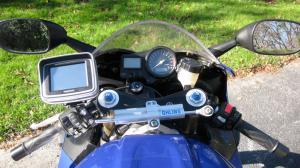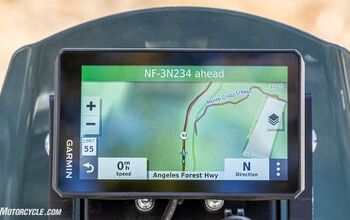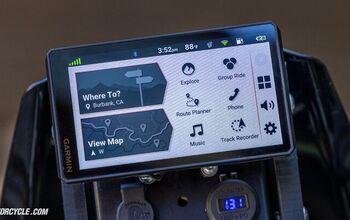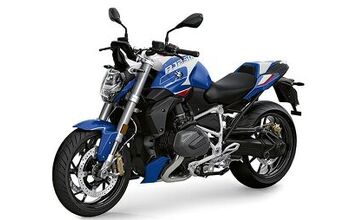Motorcycle GPS Review
We spent a month comparing the TomTom Rider 2nd Edition (MSRP $649.95), and Garmin zūmo 660 (MSRP $799.99), the latest GPS offerings from the only two major suppliers of motorcycle-specific models in North America.
Each is advertised as being designed “for bikers by bikers,” and both were released in 2009 as second-generation devices, coming on the heels of the original Rider and zūmo 450/550 respectively.
Major features in common
The Rider 2 and zūmo 660 are said to cost more than automotive-oriented units because they are built to handle a bike’s vibration, have touch screens operable by the left or right hand with gloves on, and are water resistant to an “IPX7” rating, meaning they can survive immersion in one meter of water for 30 minutes.
Whether or not they can handle a fall obviously depends on how hard they hit, but a Garmin representative loosely alluded to a zūmo that survived a 50 mph drop off the bike. And TomTom also says its Riders are tougher than its automotive units.
Both come with swiveling ball-and-socket mounting hardware from the same third party supplier, RAM Mounts. This metal and plastic design lets you affix the GPS to either the bike’s brake or clutch bracket with longer replacement bolts, or to the bar itself with a U-bolt clamp, and is said to let you “mount your device just about anywhere.”
Depending on your style of bike, this may be true. Opting to U-clamp the mount to a first generation R1 meant having to slide the clutch lever bracket up, and the control switches down to buy a half inch of free space for it to just barely fit. This made the two GPS units interchangeable, but both nearly kissed the inside fairing at full steering lock and had to be tilted down which was less than ideal. Bikes with tubular bars out in the open should have no problem, but some may find this kit won’t work at all, and will be looking for a Plan B to improvise, fabricate or purchase.
Once attached, however, the RAM mounted units were sturdy enough to withstand Class 5 hurricane-level wind speeds. (Don’t ask how this was determined.)
Both included software loaded on CDs or available as online downloads for use on your later model PC or Mac. The programs allow product registration, map updates, memory backups, routes or maps downloaded from the manufacturers or third party map companies, plugging in multi-stop itineraries, and a host of other features and services.
Riding with the TomTom Rider 2
The Rider 2 has a 3.5-inch diagonal screen, no external speaker, and includes a Cardo SCALA RIDER single-speaker Bluetooth headset to hear turn-by-turn directions – in mono, as this GPS lacks MP3 stereo like the zūmo 660 has. And if you want to hear directions in your car, you’ll need to get the $89.95 kit that includes a speaker and power cord.
Unfortunately the new-in-a-sealed-box Rider 2 – supplied by TomTom – was dead on arrival. A call to tech support revealed the Rider 2 also had what they said was an unusual problem holding the SD memory card in place, and they asked for the defective unit to be sent back. We got a new one via FedEx the next day with profuse apologies from TomTom’s rep, who’d taken it upon herself to open the sealed box, and install the SD card to ensure the same problem didn’t happen again.
With the replacement now up and running, we downloaded and installed the TomTom Home software – in this case to a MacBook using OSX Tiger 10.4.11.
Overall, the software worked OK, but it did say we were out of luck using its “Operate my RIDER” function. An error message read: “This function is not yet supported for your combination of navigation device, your device’s application version and your computer’s operating system.” Oh well.
Many other no-charge downloads and services were offered, including the Home program that wanted to charge a $79.95 renewable annual subscription to update the Rider 2’s maps, which it said were outdated by seven calendar quarters. But TomTom offers a 30-day map freshness guaranty, and the TomTom rep who supplied the unit said it would be covered.
Somewhat outdated maps or not, the TomTom Rider 2 worked to get us where we wanted to go in various tests. It was reasonably simple to figure out the menu to make preference selections, or plug in an address or point of interest as a destination. The “large” QWERTY screen worked with size large gloves pretty well.
TomTom relies on maps from TeleAtlas, which it outbid Garmin for last year, purchasing the company for $2.9 billion. TeleAtlas recently announced it was independently rated as having some maps in North American, Canada and Mexico up to 10 percent more accurate than the nearest competitor, and we found no reason to doubt it.
In a few cases the Rider 2’s directions made a little more sense than routes the Garmin later chose. If we deviated from a programmed route, however – unlike the Garmin, which would patiently and insistently attempt to corral us back toward our destination – the TomTom said nothing and would have let us ride off and get lost without a peep.
The biggest issue with the Rider 2 was the hard to read display. The TomTom’s core issue is its comparatively dimmer graphics. The map layout can be changed to a variety of color schemes for daytime and night, but in every case, they have tinted background hues. In contrast, Garmin uses bright white backgrounds for vivid daytime schemes, and for the nighttime schemes, white lines are still part of the mix.
And if this wasn’t enough, the outright luminosity of the Rider 2’s display is noticeably less than that of the zūmo 660’s display when both are set to maximum brightness. This may help with battery consumption when not plugged in, but otherwise compounds the problem.
In use, the Rider 2 was just bright enough on a cloudy fall day, and it was overwhelmed at times on moderately sunny days. If it had to face a truly bright sunny day, it’s doubtful that it would be up to the task unless it was well shielded.
TomTom adds a little shield on the front of the unit, but unless one is riding toward the sun, it serves no purpose. If forced to keep this GPS, we’d be looking for an aftermarket shield (they are available) to surround and shade it for a fighting chance to see the graphics, or to improvise a better mounting location.
And with the Rider 2, it is all the more important to see the display. When faced with several turns to choose from – like on a multiple-choice highway exit – the voice prompt only says turn right or left, and fails to name the road. At these times, you’ll have to read the display to see which one it’s trying to direct you to.
At least in hearing these directions, the Cardo Bluetooth headset worked OK. It came with a power cord for home charging and held its charge for rides over six hours long. Considering it retails separately for $149.99, it is a good included value. If you get this headset, you’ll need a “Bluetooth enabled” helmet or possibly have to modify your existing one.
It’s important to have the hook-and-loop backed speaker positioned inside the helmet sufficiently close to your ear. Even after finagling it to what seemed close as possible, its loudest volume setting was just enough to hear on the highway. Cardo says some riders find they need to shim the speaker closer to their ear with added foam padding inside their helmet, but as tested, we would have opted for it to be a little louder.
If any feature truly belonged in the “what in the world were they thinking?!” department, it was the lack of access to the battery, which is sealed inside the screwed-together case.
Posing (truthfully) as an interested prospective buyer, we called TomTom customer service to inquire about the unit’s serviceability. The rep smartly informed us that the battery would never need replacement because it’s rechargeable. OK, fine, we replied, but even lithium-ion batteries have a limited lifespan of around 500 charge cycles, and then eventually die after a few years. What then? At this, the rep said if the battery fails, we would just have to keep it plugged in all the time. We replied this is not such a great option, and asked if the Rider 2 could be sent back to TomTom for them to replace the battery? No, she said.
If she was correct or not, this was in any case pretty ridiculous. There are aftermarket companies selling batteries for do-it-yourselfers, but if you crack this unit open, don’t expect warranty coverage, and unknown is whether it would affect its water resistance.
In sum, the main redeeming features to the Rider 2 are the purportedly slightly more accurate maps, and a much lower price. Its MSRP is just $150 less than the zūmo 660’s, however many sellers discount the Rider 2 significantly, making it possible to buy it for far less than a discounted zūmo 660 would cost, especially when factoring a purchased headset.
| What's in the Box? |
| • Rider 2 |
| • Memory card (SD) containing the application and maps |
| • Mounting kit: Holder, Handlebar Mount, Handlebar Adaptor, Mirror Mount, Adhesive Mount and adhesive pad |
| • Screws and Allen wrenches for the mounting kit |
| • Wiring Harness |
| • Home charger, with international adaptors |
| • TomTom RIDER case |
| • USB cable |
| • CD-ROM with full manual as well as a tool for backing up the memory card |
| • Bluetooth headset module and headset cable |
| • Helmet headset |
| • Standard headset |
| • Screen coth |
| • Domunentation pack |
| • Product code card |
If you are thinking you might like GPS on your bike, but are not sure you’re ready to commit to a high-end motorcycle specific model, the Lowrance Endura Sierra at least deserves an honorable mention.
Officially, Lowrance says they are not pursuing the automotive GPS market, let alone motorcycle market, so why did we test it?
Because even though it lacks some features found on the moto-specific Garmin zūmo 550/660 or TomTom Rider 2nd Edition, the Lowrance Endura GPS might be able to do the job for you on a bike (or in a car), plus open a world of opportunities for trail adventures as well.
The Endura Sierra is designed as a rugged outdoor-oriented handheld model, rated water resistant to IPX7 specs, meaning it can survive a dunking under one meter of water for 30 minutes if it had to, and its touch screen can be operated with gloves on.
As a motorcycle navigation device, with the addition of an optional microSD card ($99), it will be ready to go with road maps and voice prompts for turn-by-turn directions.
Granted, this GPS lacks wireless Bluetooth headset capability and a DC power cord to the bike, but it will last over a day on a couple AA alkaline batteries (and disposable lithium batteries are said to last twice as long).
To hear the directions on the road, you will need a suitable headset. We found a set of inexpensive earbud style headphones worked fine. These also let us listen to stereo road tunes from its MP3 player, a feature the more expensive TomTom Rider 2 lacks.
Because the Endura Sierra is as small as a walkie talkie, we were able to tuck it in a coat pocket, and ride unencumbered with no wires dangling. If you wanted to mount it so you can see its 2.7-inch diagonal map display that also would be doable with a little effort.
In getting us from point A to B, we had no problems, and could foresee using this on a longer road trip. While the turn-by-turn navigation does not name the streets it directed us to, it did offer a fine degree of verbal description and worked pretty well. For example, it would say turn right immediately, or use other qualifying terms to help pick the correct turn while on the road, instead of just “turn right.” This helped especially when there was more than one potential right turn (or left) to take.
While we tested the Endura Sierra, either the Sierra ($499 MSRP) or its cousin the Endura Safari GPS ($349 MSRP) can be used for road navigation with the addition of the $99 Road Nav microSD card. Then once you’ve arrived at your destination, you can also use either of these for a whole bunch of other recreational activities, if you are so inclined.
| Both Lowrance Endura units offer the following: |
| • Offroad and trail navigation – either on a motorcycle, in a car, or on foot while hiking, riding a bicycle, or on the water. Preloaded outdoor content includes advanced outdoor mapping, campsites, lake and river detail, trails, etc. |
| • They can further be loaded with detailed hiking and bicycling directions for offroad trails, such as those found for free on the Internet from sites such as Backpacker.com and EveryTrail.com. |
| • Additionally, Lowrance offers a number of optional maps to add support to each on or off-road function, including Road Navigation, AccuTerra® Advanced Outdoor Mapping, and various marine charts and content (Navionics® marine content is coming in January on microSD). |
| • These GPS units are also geocaching friendly with paperless geocaching capability supported by Geocaching.com. |
| • If you wanted to, you could record a cross-country trip with the Endura GPS and give updates to your friends and family each night by emailing them your recorded trip to view on Google Earth as a GPX file. |
| • These units will also let you download historic points of interest or trails along with descriptions from anywhere on the Internet as a GPX file and then use the GPS as your tour guide to take you to these destinations. |
Conclusion
We found the Lowrance to be ideal for outdoor navigation while capable of performing on-road motorcycle navigation with the Road Nav microSD card, headset, and aftermarket mount.
The GPS, card and mounts combined could cost less than motorcycle-specific units but you would have to accept some sacrifices, including smaller screen size and lack of Bluetooth capability.
Lowrance Endura Sierra - As tested: $598
Zooming with the Garmin zūmo 660
Garmin says the zūmo 660’s plastic case resists damage from UV light and fuel splashes, and it’s the company’s first motorcycle-specific GPS to come with an external speaker. If you really feel like testing whether it is waterproof, you can switch it on, and immerse it in a bucket of water and listen to voice prompts – Garmin invited us to try it!
This said, the speaker is actually only meant for automotive use, for which this unit is good to go. Included are a windshield suction cup ball (RAM) mount and a second cradle/wiring harness, which plugs into a cigarette lighter/accessory outlet.
Garmin doesn’t include a 110-volt home power cord (like the TomTom came with), but plugging it via the USB cord to a computer recharges the lithium-ion battery.
And thankfully – unlike the TomTom – the Garmin allows easy battery replacement by the user. On the back is a neatly operating release mechanism to detach a gasketed access panel revealing the battery, as well as the mini USB connection for computer hook-up.
From here, you attach the aforementioned USB cord, which has the primary function of linking the GPS to Garmin’s MapSource City Navigator software. This program installed with no problems to the Mac, said the zūmo had the latest software, and allowed access to it for downloading maps, etc.
But where the Garmin does come up short is its lack of included headset. Ideally you’d want a wireless two-speaker stereo design compatible with the zūmo’s more sophisticated Advanced Audio Distribution Profile (A2DP) Bluetooth, especially if you want to listen to its MP3 player.
Figuring out the zūmo’s features was somewhat easier to intuit than the Rider 2’s interface. And the Garmin offered much larger buttons to aim for with gloves on than the TomTom, either by opting for its QWERTY keyboard all-on-one-screen page, or particularly in “large mode.” With the latter, however, the alphabet on the lettered and numbered keyboard was spread over three screen pages, necessitating scrolling back and forth between the pages to punch in a destination address.
And overall, the cleaner graphical interface made the Garmin more enjoyable to use. On the road, its Lane Assist feature showed pretty close to accurate pictorial representations of overhead green highway signs at critical junctures.
Directions came via mapping software from NAVTEQ, which is owned by Nokia, and the main rival to TomTom’s TeleAtlas. NAVTEQ boasts that its in-vehicle navigation systems are the most utilized in North America and Europe, and OEM customers include BMW and Mercedes Benz.
Problems or glitches were few, but the navigation was not omniscient, and like the TomTom’s, was a little outdated even if its software program initially told us otherwise.
We found this out when it did not account for an exit that had been re-routed about ten months prior. Specifically, trying to take a familiar trip to Valley Forge National Historic Park, it ignored a (now) legal left turn, which had not previously existed.
It was a bit baffling to see the park entrance in plain view just 250 yards to the left, as the Garmin directed a right turn away from its destination, and a subsequent series of right turns for a one-and-a-half mile detour to the same entryway it had just ignored.
On another occasion, the Cardo headset inexplicably stopped speaking (while the GPS mutely continued to display where to turn). It only started working again after shutting the GPS off and restarting it. Also, some routes were slightly more roundabout compared to the same routes mapped by the Rider 2 (both were set to take the “fastest” way).
Another issue was distance estimates were sometimes correct, and sometimes way off. Sometimes it would anticipate course changes fine. We quickly learned to ignore it however, when it would say something like, “go straight for 200 yards,” and that would have headed us over a curb, into a corporate office park’s lawn, or “turn left on XYZ road in 300 yards,” when it was actually maybe 30 feet away.
This goes with the territory with this still budding technology, however, and while obviously noticeable, did not prevent successful navigation.
If you are familiar with Garmin’s automotive nüvi line of GPS units, the zūmo is essentially like one of those, but built for the bike and priced like it.
The zūmo’s MSRP of $799.99 is a couple hundred more than the similarly equipped (but not water or impact resistant) nüvi 765T.
And after scoping for online deals, the zūmo’s current street price is about three to four hundred dollars more than the Rider 2’s lowest street prices. On principle, this is kind of irksome, because it’s doubtful its cost of production is that much more, and a rider would still need to buy a headset.
| What's in the Box? |
| • zūmo 660 |
| • Preloaded City Navigator NT for North America or Europe (full coverage) |
| • MapSource City Navigator North America NT DVD |
| • Motorcycle mount with integrated power cable and mounting hardware |
| • Carrying case |
| • Battery pack |
| • Automotive suction cup mount |
| • Automotive power cable |
| • USB cable |
| • Dashboard disk |
| • Quick start manual |
Conclusion
We started out by saying TomTom and Garmin are the only two major suppliers of motorcycle-specific GPS units in the North American market. Some might point out that BMW, Harley-Davidson and Honda all provide optional GPS. This is true, but if you don’t already know, these are all made by Garmin.
Retailers also offer crossover, outdoor and marine-oriented GPS units equipped with street maps that can work on a bike, but at present, the commitment to motorcyclists as primary consumers has come only from the makers of the two products reviewed.
And as you can see, neither is perfect, but both can get you where you want to go.
It was the zūmo 660, however, that had fewer issues, and seemed more thoroughly engineered, as evidenced most by its accessible battery, external waterproof speaker, and larger, brighter display screen.
The result was it wound up being easier to live with, and left little doubt as to which was the one to get – if not factoring price considerations, and arguably in spite of its higher price.
It’s true that it lacks a headset while charging $150 MSRP more than the TomTom, but unlike the Rider 2nd Edition, the zūmo 660 does come ready for car use, and on the bike it clearly set the standard.
More by Jeff Cobb



































Comments
Join the conversation